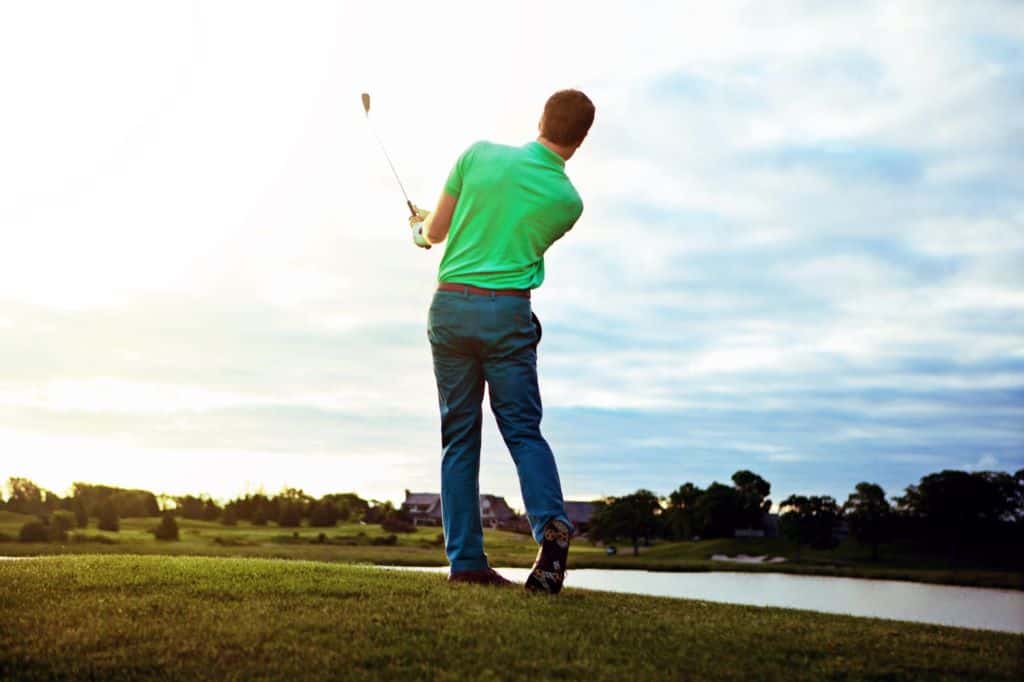Whether you are a weekend golfer or a PGA Tour professional, there is an endless pursuit to master the golf swing. Think about how many Hall of Famer Tiger Woods has rebuilt his swing, and that swing won several PGA Majors, including the Masters.
However, most amateur golfers focus on the wrong pieces of the swing to deliver better results. Assuming that you have already addressed your posture and address to the ball, let’s dive into the first movement of your golf swing, the takeaway.
What Starts The Takeaway In Golf?
When talking with golfers about their swing, you will hear many of the same topics, “I am swinging over the top,” “I am leaving the clubface open,” “I do not have enough lag,” and so on. These things may all be accurate, but the amateur golfer rarely recognizes that the golf swing mainly revolves around science, geometry, and physics. Their swing faults are generally a reaction as the body compensates for the poor mechanics that begin with the takeaway.
Correctly starting your golf swing has a significant impact on how you perform on the golf course. If you begin out of sequence or on the wrong path, everything action following is actually a reaction and compensation.

Master Your Golf Swing… In A Few Easy Steps.
Keep in mind the golf club face is merely a few square inches of contact space and must be controlled through the moment of impact.
To simplify the idea of starting your takeaway to the lowest point, we will break it into two steps that you can do anywhere you have room to swing a club. The movements that we go over will be based on feel to help you understand what you are looking for at the absolute beginning of your swing. We will also go over a few checkpoints to look for early into the takeaway to ensure that you in the right path.
First Part Of The Movement
The first thought movement we will be looking for revolves around the hands. We know that hands are crucial in delivering solid contact to the ball and controlling the trajectory. The left-hand controls the clubface, and the right controls your clubhead; reverse these for left-handed golfers.
It is simple when you break it down, and if you are overthinking it, grab a golf club and do some very light swings with each hand. It will be very noticeable that your left-handed swing will almost square themselves up around impact. The right-handed swing will allow you to control the club position better but give you more flicking motion.
Seeing how involved the hands are with the overall swing, it is not a massive surprise that the golf swing begins with the hands moving. The first movement should be from the butt of the golf club, with your clubhead immediately following.
Many think that swing start moving the clubhead; however, this can result in rolling the wrists and taking the club off the plane or setting the wrist hinge too soon, leading to early extension. Having the butt of the club be the first movement will allow you to control your swing plane truly. Be sure not to overdo this step; the hand move first, but the clubhead should immediately follow.
The Second Part Of The Movement
The second feeling we are looking for happens in your feet, specifically your trail foot. As you begin your takeaway, you should feel your weight shift from an even position to one that has about 75% on your back foot.
The part you will be focusing on will be the trail foot’s heel. Almost immediately, you should feel your weight shift, and if you swing correctly, that weight will change to the trail foot’s heel. An easy way to make sure you feel that movement is to put something small and flat directly under your heel.
The small object under your foot will not impact the swing significantly, but it will exaggerate the feeling and help you notice where you are putting the pressure.
Key Takeaways
Using the two swing thoughts above, complete some small swings wherever you can and notice the feeling. I always recommend not taking swings with a golf ball when practicing a new drill.
The ball adds an entirely unnecessary thought process that could take away from your focus and awareness.
After a handle of swings, incorporate a golf ball and clear your mind. If you took the swings prior seriously and focused on the feelings, you will not have to strike the ball. The brain is very powerful; let it do the work.
After you become more comfortable with those swings, you can use these checkpoints to make sure you start the backswing in good form. Does the clubface remain square to the golf as you work backward away from the ball? If not, begin again, keeping the clubface closed.
This last checkpoint provides excellent feedback about your swing plane that it has earned its spot as Position Two in the golfer P-Classification-System with the title, “The Takeaway.” You are looking for two items from this position: if your clubhead is still closed (45-degree angle at P2) and your overall golf club is parallel to your target line.
Start the drill over if you get to this point and do not see these checkpoints hit.
I think it is easy to see that your takeaway, while only a tiny piece of the swing, can be something that sets you up for success or a long day in the weeds.
